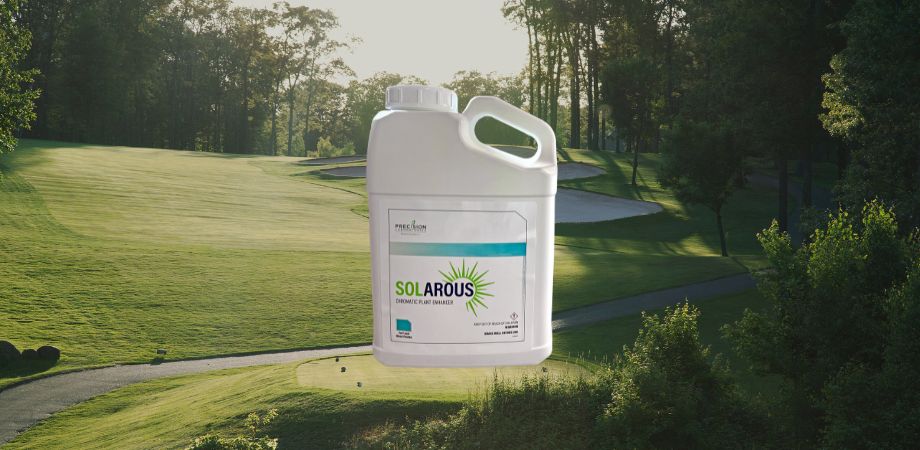Keeping courses pristine during the hot summer months can be challenging, especially when it comes to controlling weeds that thrive in high temperatures. There are five major hot weather weeds that superintendents are likely to encounter.
Doveweed
Doveweed (Murdannia nudiflora) is a summer annual weed that grows in moist, warm environments. It has fleshy, narrow leaves and produces small blue flowers. Doveweed typically emerges in the late spring to early summer months and can spread quickly. It forms dense mats that can quickly outcompete turf. Courses with excessive irrigation and areas with poor drainage are especially susceptible to doveweed.
Virginia Buttonweed
Virginia buttonweed (Diodia virginiana) is a perennial broadleaf weed that prefers wet, warm conditions. It can be identified by its small white flowers, which have a star-like appearance. Virginia buttonweed often appears in late spring and persists through the summer. It is particularly problematic in low-lying, poorly drained areas.
Spurge
Spurge (Euphorbia spp.) is a low-growing summer annual that can spread rapidly in hot, dry conditions—especially in areas with poor soil conditions. It has small, oval leaves that produce a milky sap when they are broken. Spurge typically appears in early summer and can, like doveweed, form extensive mats. These mats are most common in thinning or stressed areas.
Prostrate Knotweed
Prostrate Knotweed (Polygonum aviculare) is an annual weed that thrives in compacted soils and high-traffic areas. It has wiry stems and small, blueish-green leaves. Knotweed emerges in early spring and can stick around through the summer. It’s often found on pathways, in tee boxes, and in other areas where soil compaction is common.
Lespedeza
Lespedeza (Lespedeza spp.) is a perennial broadleaf weed that, like spurge, favors hot, dry environments. It has trifoliate leaves and makes small flowers that appear purple and/or pink. Lespedeza typically appears in late spring and can be especially problematic in areas with poor soil fertility. Its deep root system allows it to withstand drought conditions, making it difficult to control once it’s established.
Cultural Practices for Weed Management
Having healthy turf the first line of defense against weeds. Here are some key practices that can help turfgrass thrive in hot conditions:
- Avoid Mower Scalping: Scalping can weaken turf and create openings for weeds to establish. Superintendents and groundsworkers should frequently make sure that mower heights are adjusted properly and that blades are sharp. Cutting too low, especially during hot weather, can cause roots to weaken and make it easier for weeds to appear.
- Use Proper Irrigation Techniques: Overwatered areas and areas with poor drainage are ideal growing areas for summer weeds. Implementing a deep, infrequent watering schedule can encourage deep turf root growth while simultaneously reducing surface moisture, which helps weeds germinate. Ensuring that irrigation systems are properly calibrated to avoid overwatering is important, too.
- Reduce Thin Areas: Having thin turf makes it easier for weeds to establish, spread, and outcompete turf. Regular aeration, overseeding, and proper fertilization can help superintendents maintain a dense, healthy stand that competes well against weeds.
- Use Amino Acid Products: A high-molecular-weight amino acid polymer like Foliar-Pak Armament Concentrate, which helps improve nutrient uptake by making more nutrients available, can help improve stress tolerance and form deeper, stronger roots.
Using Herbicides on Hot Weather Weeds
Herbicides should be used to control hot weather weeds when cultural practices alone aren’t effective. Pre-emergent herbicides should be applied prior to weed germination, while post-emergent herbicides should be applied when weeds are small and actively growing.
Pre-Emergents
Pre-emergent herbicides are typically the most effective way to control difficult weeds. These products are most often applied in the spring, around the time that forsythia blooms. When planning applications, superintendents should keep in mind that high temperatures can break chemistries down quicker. To keep up, split applications in April/May and then at the end of June are common. Products containing dithiopyr and prodiamine are some of the most common—and most recommended—pre-emergents.
Post-Emergents
Post-emergent herbicides can be used to control weeds on the course, but establishing pre-emergent control is the best course of action. Products containing 2,4-D, dicamba, and/or quinclorac are often recommended for control of weeds after they’ve germinated.
Best Practices for Application
Herbicide applications during extreme heat or drought conditions should be avoided, since that can reduce their efficacy and increase the risk of turf damage. Applicators should always read and follow label instructions, too.
Properly managing tough weeds helps superintendents keep the quality and playability of their courses up to par. For product recommendations and tips tailored to your course’s turf type, region, and other factors, reach out to your ATS rep.












